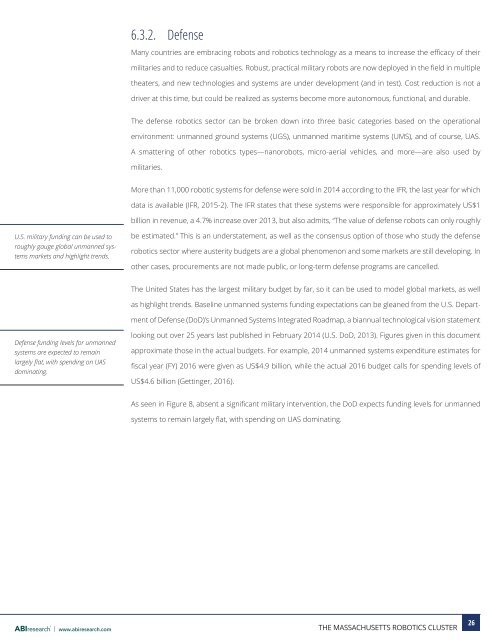ROBOTICS CLUSTER
Massachusetts%20Robotics%20Cluster%20Report%20Final
Massachusetts%20Robotics%20Cluster%20Report%20Final
Create successful ePaper yourself
Turn your PDF publications into a flip-book with our unique Google optimized e-Paper software.
6.3.2. Defense<br />
Many countries are embracing robots and robotics technology as a means to increase the efficacy of their<br />
militaries and to reduce casualties. Robust, practical military robots are now deployed in the field in multiple<br />
theaters, and new technologies and systems are under development (and in test). Cost reduction is not a<br />
driver at this time, but could be realized as systems become more autonomous, functional, and durable.<br />
The defense robotics sector can be broken down into three basic categories based on the operational<br />
environment: unmanned ground systems (UGS), unmanned maritime systems (UMS), and of course, UAS.<br />
A smattering of other robotics types—nanorobots, micro-aerial vehicles, and more—are also used by<br />
militaries.<br />
More than 11,000 robotic systems for defense were sold in 2014 according to the IFR, the last year for which<br />
data is available (IFR, 2015-2). The IFR states that these systems were responsible for approximately US$1<br />
billion in revenue, a 4.7% increase over 2013, but also admits, “The value of defense robots can only roughly<br />
U.S. military funding can be used to<br />
roughly gauge global unmanned systems<br />
markets and highlight trends.<br />
be estimated.” This is an understatement, as well as the consensus option of those who study the defense<br />
robotics sector where austerity budgets are a global phenomenon and some markets are still developing. In<br />
other cases, procurements are not made public, or long-term defense programs are cancelled.<br />
The United States has the largest military budget by far, so it can be used to model global markets, as well<br />
as highlight trends. Baseline unmanned systems funding expectations can be gleaned from the U.S. Department<br />
of Defense (DoD)’s Unmanned Systems Integrated Roadmap, a biannual technological vision statement<br />
Defense funding levels for unmanned<br />
systems are expected to remain<br />
largely flat, with spending on UAS<br />
dominating.<br />
looking out over 25 years last published in February 2014 (U.S. DoD, 2013). Figures given in this document<br />
approximate those in the actual budgets. For example, 2014 unmanned systems expenditure estimates for<br />
fiscal year (FY) 2016 were given as US$4.9 billion, while the actual 2016 budget calls for spending levels of<br />
US$4.6 billion (Gettinger, 2016).<br />
As seen in Figure 8, absent a significant military intervention, the DoD expects funding levels for unmanned<br />
systems to remain largely flat, with spending on UAS dominating.<br />
www.abiresearch.com<br />
THE MASSACHUSETTS <strong>ROBOTICS</strong> <strong>CLUSTER</strong><br />
26


